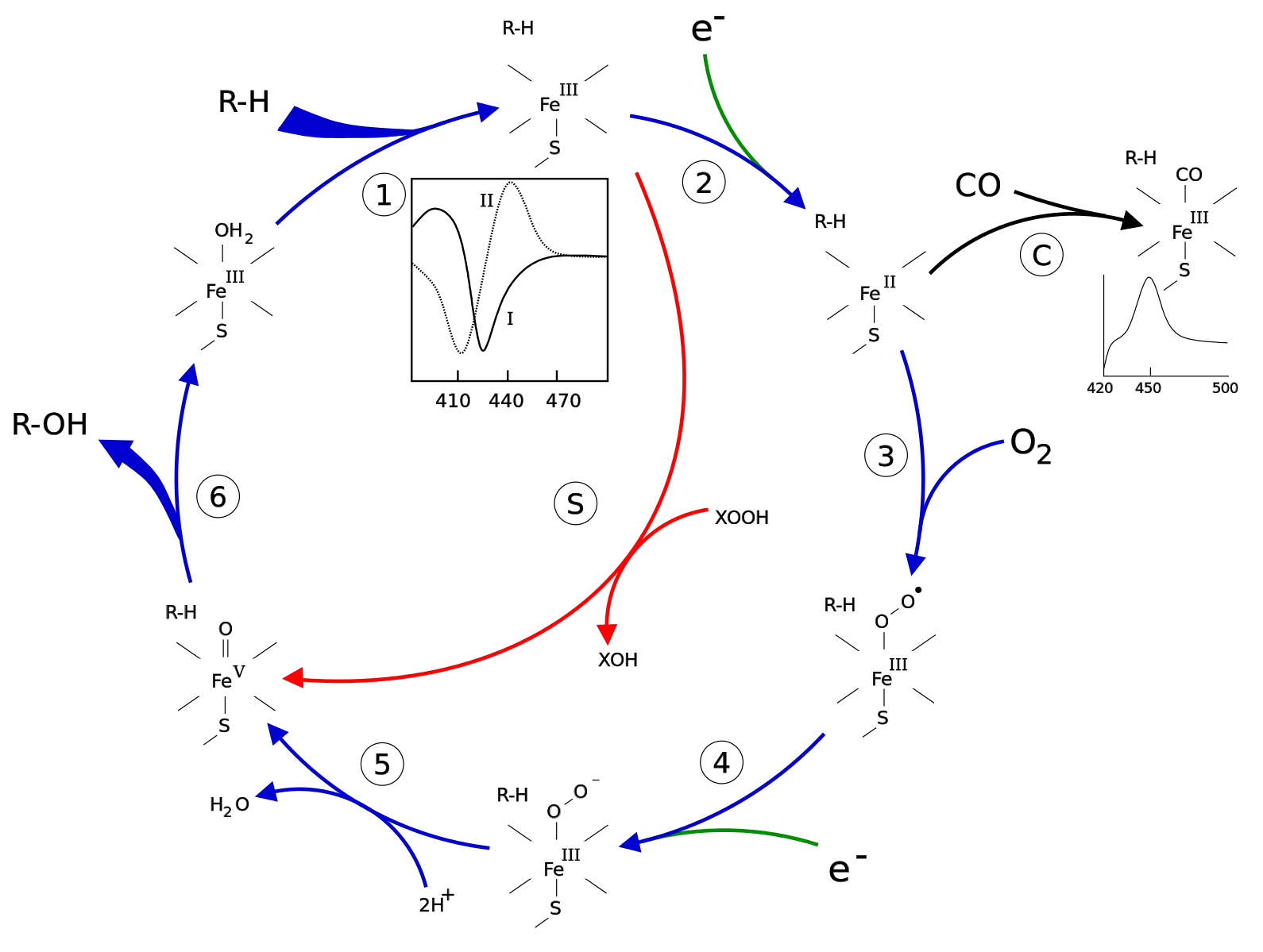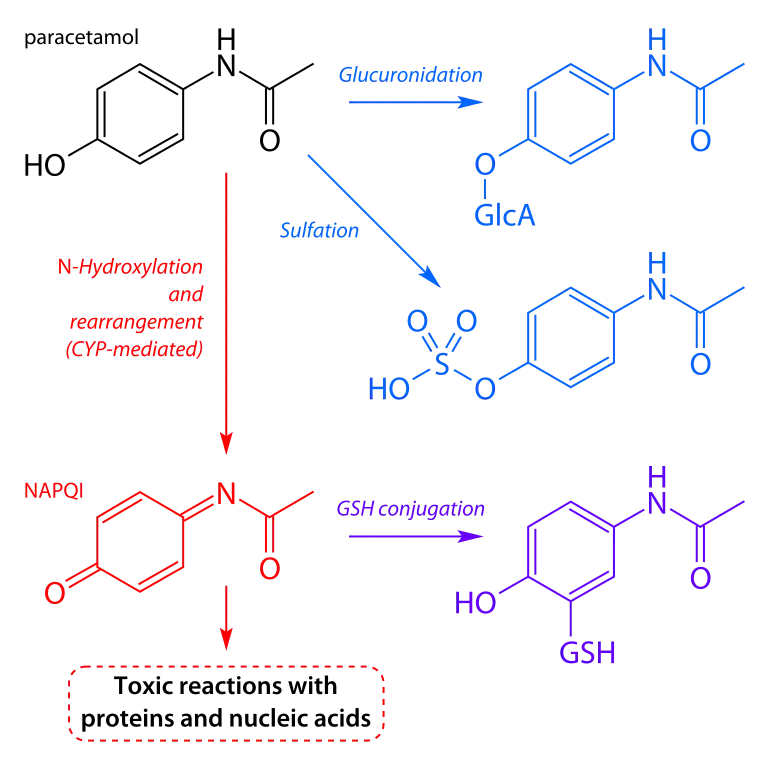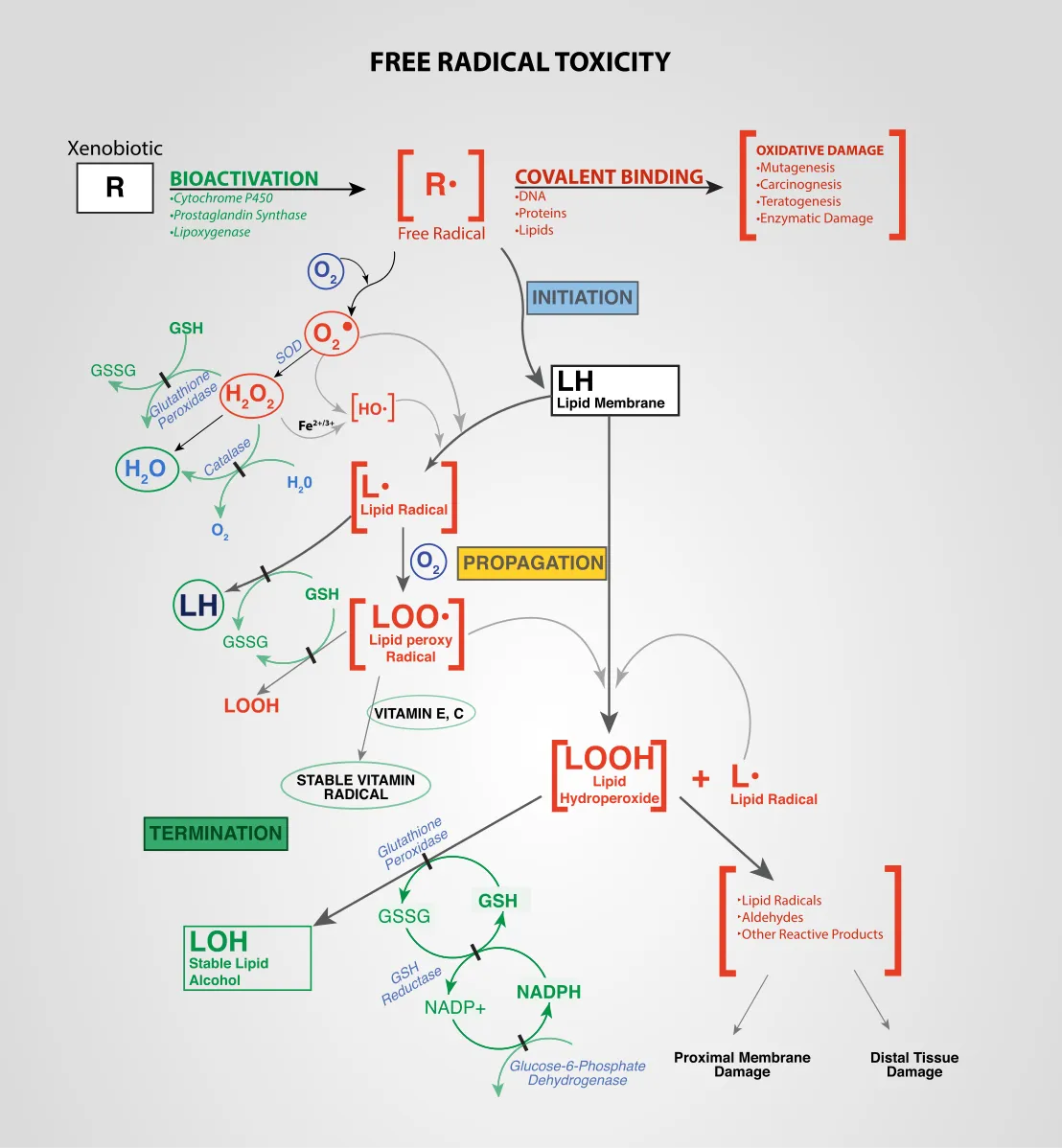The cycle of oxidative-reductive reaction that facilitates the metabolism of most exogenous chemical detoxification is usually depicted by the Cytochrome P450 cycle.
There some things that happen when you take drugs either alone or in combination. You will get to understand why that drug you took either worked either effectively after administration or did not work due to some reasons. Three things happen when you take drugs.
1. It is either the drug is made more active by the action of other drugs or induction by an enzyme in the body system or
2. It is made less active due to competitive inhibition by other drugs or
3. That there is no change in the pharmacological property of the drug. This phenomenon is known as the placebo effect which I am going explain later.
The whole series of events that occur when drug is administered is what is known as Biotransformation. Drug is a Xenobiotic, reason being that it is not produced by the body's metabolism. Let's talk more about this process of drug transformation and metabolism.
The biotransformation of drugs
Just like I defined earlier, drugs are chemical substances that could pose a serious threat when they are in high concentration. Some drugs may be too large to be absorbed or are unable to cross the Blood Brain Barrier (BBB) and as such are produced in such a way that they remain in their inactive form until they reach their predilection site where they will exert their effector function. This kind of drugs are called pro-drugs and a typical and common example is the Levodopa-an anti-parkinsonian drug used in the treatment of parkinson disease. A pro-drug has no pharmacological potency unless it is metabolised into another compound which is its active form.
Why the conversion to dopamine?
Dopamine deficiency in the brain causes parkinson disease. This dopamine ordinarily cannot pass through the BBB to get to the brain and as such its inactive form called The Levodopa (a pro-drug) which can pass through the BBB is given to patients with parkinson (a disease caused by the deficiency of the neurotransmitter - dopamine). The Levodopa is absorbed and since they are small enough to pass through the BBB, they get to the brain and are converted to dopamine which is the active form.
Pro-drugs are only active after biotransformation. Biotransformation of drugs is the the alterations in the chemical structure of a drug or chemical compound. The major essence of biotransformation is to converts lipid soluble drugs to water soluble forms that can be easily excreted out of the body either through urine or faeces. This is so evident when you take malaria drugs, the change in the colour of your urine is as a result of the bi-products of biotransformation.
When drugs are absorbed they undergo basically two phases of bio-transformation which are the phase 1 and phase 2. During the phase 1, what happens is that the drug is made more polar. They acquire some functional groups that will enable them enter the phase 2. A major reaction common in the phase one is Oxidation reaction where oxygen molecule is added to the drug and this reaction is catalysed by monoxoygenases in the liver. Paracetamol, barbiturates and steroids are common examples of drugs that undergo oxidation in the liver.
After the phase 1, the drug is now equipped with the functional groups it needs for further action during phase 2. In phase 2, there is an incorporation of endogenous substrate or put it this way, conjugation reaction occurs (binding of the metabolite to glucuronic acid, sulfates, acetyl etc. thus making the metabolite water soluble). One thing i want you to note here is that, the type of endogenous substrate that will be added depends of the type of functional group the drug acquired in phase 1. Phase 2 is the major phase that determines the route of excretion of the drug.
The drug is made highly soluble in phase 2 and without this conjugation, excretion of most drugs we take in might seem difficult as long as the the drug passes through the liver. This is why the liver is the hall mark of drug metabolism and when something goes wrong, metabolism of these drugs becomes a critical issue.
Paracetamol poisoning as a case study
(Acetaminophen) or what is commonly known as Paracetamol is normally metabolised by conjugation to supbate and glucuronide and none of these as well as the unchanged paracetamol is toxic. These products are excreted in urine, however a small fraction of paracetamol is converted to a reactive metabolite called N-acetyl-p-benzoquinoneimine (NAPQI) by the enzyme Cytochrome P450 mixed function oxidase in the liver and this reactive metabolite is responsible for the toxicity of paracetamol.
This N-acetyl-p-benzoquinoneimine is normally detoxified by being conjugated to glutathione and excreted in urine. In a situation where the enzyme is induced by other drugs, for example by alcohol. The action of the enzyme on paracetamol will be so high that the reactive products produced supercedes the conjugating ability of the liver. This consequently results to glutathione depletion and binding of these reactive metabolite to cells, proteins and nucleic acids of the liver and in the process causing necrosis (pathologic death) of the liver tissues.
This is basically what happens during paracetamol poisoning and when there is failure of effective biotransformation of drugs. There are other toxic metabolites that are cleared in the body through other pathways as you can see from the diagram above. As for Paracetamol poisoning, worry less because there is good news. There is an available antidote for paracetamol poisoning and this is a drug by chemical name- N-acetylcysteine. This drug works by converting the reactive metabolite to non-reactive form which is then excreted through urine. This case study here is a typical example of the effects of drug-drug interaction leading microsomal enzyme induction.
Do you know this👇
Did you know that the metabolite of cocaine - Benzoylecgnonime after degradation by hepatic plasma esterase can remain in the plasma for about 2-5 days. The metabolite is seen in urine after degradation by the liver enzyme and because of their long duration of stay in the plasma, it makes it easier to detect or catch athletes involved in doping (administration of drug to improve performance).
Back to the matter!
Ever wondered why you are always advised not to take a medication with cold water? 🤔 Why you are advised not to take some drugs in combination with the others? Why some times you are told to take some malaria drugs with fatty meals? Why at times you are advised not to eat anything before taking some drugs? Well wonder no more as the answers are here.
The metabolism of drugs could actually be affected by many factors like temperature (the higher the temperature the faster the metabolism of the drug and vice versa), age (drugs are metabolised slower at extremes of age), sex (males metabolise drugs faster than females due to their high basal metabolic rate and liver enzyme function) and the microsomal enzyme inductors and inhibitors. This leads us to the concept of drug-drug interactions and Synergism.
The drug and the food
Some drugs are lipid soluble and thus their body distribution aka volume of distribution will be high provided they are transported bound to plasma proteins. Taking the drug with fatty meal will enhance their absorption in the gut. Been lipid soluble, passage through the cytoplasmic membrane which is a bi-lipid layer will be much more easier. Most malaria drug for example are much more effective when taken with fatty meal.
Drug-Drug interaction and Synergism
If you have read my initial article about drug concept, you will understand that drugs act through a receptor, hence the reason for their specificity. They act by binding to their specific receptor located on the target site. Now in a situation where we have two drugs that have the same affinity for the same receptor, what then happens? Hmmm, good question!
The battle of the fittest
In a situation where two drugs have similar interest for the same receptor site, the drug with the highest affinity binds to the receptor site of the target organ and in the process makes the other drug less efficacious. This is what is known as competitive inhibition. This is why polypharmacy (the use of multiple drug therapy) is usually not encouraged especially if one is not sure of the mechanism of action of the drugs used in combination.
Don't conclude yet
Dear, before you conclude that drug didn't work on you, kindly check, probably you used two drugs that are antagonistic in action or probably you may have abused the drug? or it could be that your body system is now used to the drug and as such the receptors are exhibiting what is known as tachyphylaxis (non responsive state of receptors to external stimuli) . This is something worth pondering on.
The competition between the two drugs is just like the theory of natural selection where there is survival of the fittest. The drugs with higher affinity binds and makes its metabolism faster while the other's metabolism is either reduced or totally inhibited.
polypharmacy
The use of multi drugs can only be effective and produce the required result if the two drugs complement the action of the other. The case study I explained above talked mainly about how a drug can induce the over-activity of an enzyme but doesn't talk about what it does to the other drug. When drugs oppose each other action, they are said to exhibit antagonistic action or they are called antagonists. But if they complement the effect that of each other to produce a much more stronger effect than would each one singly, then they are said to exhibit what is called synergism and as well can be said to be synergistic in action.
The synergism of drugs is very much needed in situations where the use of a single drug is unable to treat disease or infection. For example in the treatment of some sicknesses like malaria, bacteria infection, the concept of synergism play a crucial role. Now you understand why some times the pharmacists mixes a whole lot of different drugs (polypharmacy) just to cure that illness you complain about. Kindly bear in mind that it is for your own good most times, though there are more expensive drugs that could actually take care of the problem at once, but, the pocket of the patient is most times considered before drug prescription.
Your money speaks
If you have the cash, you might as well go for the single dose therapy which are usually very expensive. Example of drug synergism include the combination of Sulphamethoxazole + Trimethoprim combination which gives Cotrimazole with trade name of Septrin, you also have the combination of Sulfadoxine + Pyrimethamine which gives the popular malaria drug called Fansidar and the last on my list is another popular drug called Augmentin which is made up of Amoxicilin + Clavilanic. The list is endless.
Synergism becomes very important in the treatment of diseases like tuberculosis - a disease caused by the the bacteria Mycobacterium tuberculosis and leprosy (Hansen's disease) another disease caused Mycobacterium leprae. These are two of the most stubborn bacteria infection that are highly resistant to treatment if proper care is not taken.
Dread some drug combinations
Dreaded combinations of drugs that could really deal with you. For the alcoholics, please veer off this dangerous combination below. The list here is not exhaustive enough as there are more other combinations totally not advisable
-
Alcohol and Paracetamol (the alcohol will induce the the liver enzyme leading to excess Paracetamol metabolite)
-
Alcohol and Disulfiram (Disulfiram will inhibit the complete metabolism of alcohol leading to alcohol metabolite accumulation)
-
Alcohol and Metronidazole aka Flagyl (this produce similar effect like that of alcohol and Disulfiram)
-
Alcohol and cocaine (this combination produces cocaethylene which is equipotent to cocaine in blocking the re-up take of dopamine)
Some of the drugs that could induce or speed up the metabolism of other drugs include Barbitones, antipyrine, Ethanol(alcohol), Vitamin C (Ascorbic acid), Testosterone, Phenytoin etc. While those that are inhibitory in action are Quinidine, Disulfiram, Omeprazole, Propranolol, Fleicaninide etc.
The placebo effect
Now is the time to talk about this weird phenomenon called placebo effect. How on earth will one take a drug which actually is chemically inert and yet it gives you that feeling that it actually worked in your body.
Placebos are majorly prescribed for your mental relief than for its effects on a particular illness. By definition, placebos are drugs that are chemically inert and they are used especially in controlled experiments to test the efficacy of another substance. They are just those drugs that do nothing in the body.There are situations when we think that a drug must cause some sort of discomfort as a surety or guarantee that it works. Most times our psychology plays a crucial role in our recovery from some illnesses. Some people do not believe in drugs and even during when they are sick they just stick to their believe. Yes at times this works because the way we condition our mind to treatment matters a lot. But there are times when one is left with no choice but to yield.
Your psychology plays a role
When you believe you are going to be fine and recover from whatever might be a problem afflicting you, there is high chance of full recovery. The psychology of man is one of the key factor in therapeutics and the way we condition it to treatment with drugs matter. What if I tell you that not all the drugs the doctors prescribes for you are active, some times he can give you a placebo so that you don't bother him anymore.
disturb him too much: you get a placebo
When the doctors tells you that you are going to be fine after some discomfort or maybe a mild pain and you keep pestering him to prescribe drug that will do the miracle. Because you have conditioned your mind that once a drug is prescribed for you, automatically you are going to be fine, he is likely to do your wish. But don't be surprised, you will end up getting a placebo as a prescription from him.
Until next time😉✌️
References
¶biotransformation ¶Textbook of pharmacology, Edited by P. Iwe. Akubue ¶Essentials of medical pharmacology by K.D. Tripathy. 8th Edition, page 11-37 ¶aidsinfo-drug Synergism ¶Drugs ¶drug metabolism If you write STEM - Science Technology Engineering Mathematics related posts, consider joining @Steemstem and @Stemng.
Return from Let's talk about Xenobiotics, biotransformation, Drug Synergism and the Placebo effect to cyprianj's Web3 Blog






